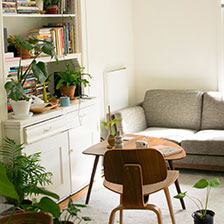These days we are getting more and more into making the most of our space and Millennials especially it seems are looking for something to nurture.
“The latest fashion in housing seems to be the explosion of people wanting to create so called indoor jungles. This is a great way to make your home unique and special and also to increase the quality of the air which often in built ucity areas can be a wonderful thing. We look to give people the best Mortgage rate we can but saving money and being more eco conscious is always a good thing and to do something naturally such as purify the air and make the place fragrant is a worthwhile task.” Home Trend and Bridging Finance Experts from UKPropertyFinance.co.uk
Creating an Urban Jungle with House Plants
The quality of air inside your living space can massively contribute to your state of mind and mood. Installing house plants will maintain a person’s health in homes and places of work. They look presentable and improve the air quality by removing pollutants, allowing us to breathe more freely. Furthermore, they have shown to assist in mental and physical health conditions.
Sales of house plants has rocketed since the benefits have become more widespread in the mainstream media. Numerous scientific studies have experimented with a range of indoor style plants and the results are positive. Having indoor plants includes many benefits that will boost a person’s psychological health. The main areas that has shown to improve are mood and stress levels. Including plants in a work environment can increase productivity, as well as, the speed of reaction when completing activity on a computer. They have also been able to prove that plants can improve attention spans, keeping people more focused on the task in hand. All of these main areas are hugely important for a healthy lifestyle and routine. Places of work and schools would gain a lot from having a well maintained urban jungle, to help morale and lift the mood of the people involved. The perfect place to start your indoor plant adventure is The Nunhead Gardener Centre in South East London, where they have an oasis of foliage on offer. A great place to gain knowledge and chose your ideal family of houseplants.
Mental health has been the buzz word recently in the media and should be a topic of discussion, but let's not forget the physical aspect. Physical health is obviously just as vital and house plants can help improve people’s breathing. As the plants remove the build up of airborne pollutants and toxins, the air within the room becomes lighter. This can have great affects, reducing blood pressure, reducing tiredness and fatigue, reducing the amount of headaches and migraines. These health benefits can not be ignored, with hospitals even reporting a reduction in pain in patients when the ward has a selection of indoor plants. One of the only downsides to this is that some people reported slight skin irritations, but these were isolated cases and not common.
Keeping windows open is important for air circulation but it is harder during the winter months due to the cold temperatures. People are spending more time inside and gaining less exposure to vitamin D. This is where a carefully selected range of indoor plants can start to work their magic, cleaning the room of any nasty toxins. Below is a list of great choices for your urban jungle, each one working in a different, unique way. It is a fun, low maintenance hobby, that is really educational for young minds, exploring the world of bio diversity and science. It is easy to follow and find social media accounts that promote the importance of indoor spaces, making it fun for all the family.
Amazing indoor plants that improve the quality of air include:
For removing benzene and formaldehyde:
Chlorophytum comosum (spider plant)
Dracaena fragrans (dragon plant)
Dracaena marginata (Madagascar dragon tree)
Epipremnum aureum
Ficus elastica (Rubber plant)
Hedera helix (English ivy)
Nephrolepis exaltata (Boston fern)
Sansevieria trifasciata (mother-in-law’s tongue)
Syngonium podophyllum (Nephthytis)
Zamioculcas zamiifolia (fern arum)
For removing just formaldehyde:
Aglaonema ‘Silver Queen’
Rhapis excelsa (bamboo palm)
Spathiphyllum (peace lily)
For removing just benzene
Aspidistra elatior AGM (common aspidistra)
Chamaedorea seifrizii (bamboo palm)
Crassula ovata (jade plant)
Dieffenbachia (dumb cane)
Howea forsteriana (flat palm)
Research shows that every year over four million humans pass away due to indoor air pollution. Often the air indoors can be worse than outside and this is because of higher amounts of nitrous oxide and carbon dioxide. These dust like particles become trapped within the house and cause nasty damage to the humans respiratory system. Other indoor contaminants, named as volatile organic compounds, derive from furniture, cleaning products and paint. They include substances like toluene and benzene, which both have adverse effects on people and animals. Using aerosols can also add to the poor air conditions as they spread spores and bacteria. All of these air pollutants contribute to an unhealthy environment that can cause irritations to a person’s eyes, nose and throat. These irritations can then lead to nauseating headaches, fatigue problems, triggering asthma attacks and skin rashes.
Ways to Make Your House Special – Creating Indoor Jungle



